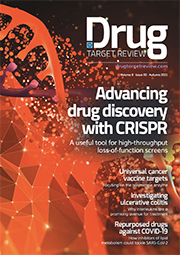Application note: CRISPR/Cas9 genome-edited cells express nanoBRET-donor that monitors protein interaction and trafficking
Posted: 12 April 2018 | BMG Labtech GmbH, Carl White (Molecular Endocrinology and Pharmacology), Ethan See (The University of Western Australia), Kevin Pfleger (Dimerix Limited) | No comments yet
In this application note, BMG Labtech discuss how the Bioluminescence resonance energy transfer (BRET) is a versatile tool to study interactions and trafficking in proteins.
GPCRs are important drug targets requiring receptor-protein interaction and trafficking studies to reveal how they function. Bioluminescence resonance energy transfer (BRET) is a versatile tool to study such interactions and trafficking. Hitherto, it is limited by the ectopic expression of labelled interaction partners. CRISPR/Cas9 genome editing overcomes the limitation by enabling endogenous expression of luciferase-labelled proteins.
CRISPR/Cas9-edited cells endogenously expressing a CXCR4/NanoLuciferase fusion protein were used in conjunction with β-Arrestin/Venus to monitor receptor activation. Employing two fluorophores fused to a membrane and endosome standing CXCR4-interacting protein, respectively, allowed for monitoring of receptor trafficking.
The novel CRISPR/Cas9 technique successfully fused the Nluc BRET donor to endogenously-expressed CXCR4. The resulting protein levels were sufficient to monitor receptor interactions as well as internalization. The internalization assay depends on two acceptor fluorophores whose selective detection was rendered possible by the CLARIOstar’s monochromator.
This application note is restricted - login or subscribe free to access


Why subscribe? Join our growing community of thousands of industry professionals and gain access to:
- quarterly issues in print and/or digital format
- case studies, whitepapers, webinars and industry-leading content
- breaking news and features
- our extensive online archive of thousands of articles and years of past issues
- ...And it's all free!
Click here to Subscribe today Login here
Related content from this organisation
- Product hub: High-throughput screening of cyclic peptide libraries for developing drugs to challenging targets
- Application note: Screening for optimal association and dissociation rates of ligands using a live cell binding assay
- Expert view: Promising methods in kinase screening
- Screening In-Depth Focus 2019
- Under the microscope: Improving hit discovery efficiency at Europe´s leading screening centre
Related topics
Cell-based assays, CRISPR, DNA, Genome editing, Genomics, GPCRs, Ligands, Protein, Screening
Related organisations
BMG Labtech GmbH





